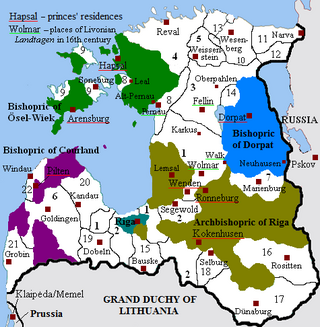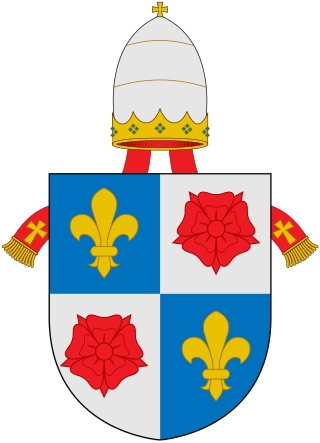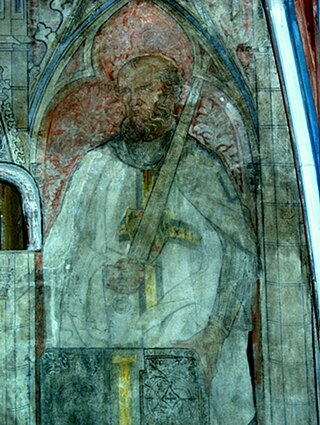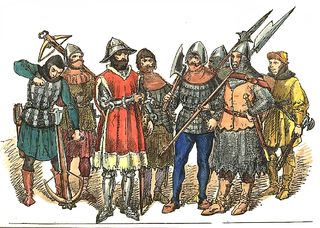Related Research Articles

Livonia or in earlier records Livland, is a historical region on the eastern shores of the Baltic Sea. It is named after the Livonians, who lived on the shores of present-day Latvia.

Pope Urban IV, born Jacques Pantaléon, was the head of the Catholic Church and ruler of the Papal States from 29 August 1261 to his death. He was elected pope without being a cardinal; he was the first to be elected in such a way, and this would occur for only 3 more popes afterwards.

The Teutonic Order is a Catholic religious institution founded as a military society c. 1190 in Acre, Kingdom of Jerusalem. The Order of Brothers of the German House of Saint Mary in Jerusalem was formed to aid Christians on their pilgrimages to the Holy Land and to establish hospitals. Its members have commonly been known as the Teutonic Knights, having historically served as a crusading military order for supporting Catholic rule in the Holy Land and the Northern Crusades during the Middle Ages, as well as supplying military protection for Catholics in Eastern Europe.

The Guelphs and Ghibellines were factions supporting respectively the Pope and the Holy Roman Emperor in the Italian city-states of Central Italy and Northern Italy during the Middle Ages.

Hermann von Salza was the fourth Grand Master of the Teutonic Knights, serving from 1210 to 1239. A skilled diplomat with ties to the Frederick II and the Pope, Hermann oversaw the expansion of the military order into Prussia.

William of Modena, also known as William of Sabina, Guglielmo de Chartreaux, Guglielmo de Savoy, Guillelmus, was an Italian clergyman and papal diplomat. He was frequently appointed a legate, or papal ambassador by the popes Honorius III and Gregory IX, especially in Livonia in the 1220s and in the Prussian questions of the 1240s. Eventually he resigned his see to devote himself to these diplomatic issues. On 28 May 1244 he was created Cardinal-Bishop of Sabina by Pope Innocent IV. For a short time (1219–1222) he served also as Vice-Chancellor of the Holy Roman Church.

Heinrich Walpot von Bassenheim, also known as Henry Walpot, was the first Grand Master of the Teutonic Knights serving from 1198 to sometime before 1208.
Gerhard von Malberg was the sixth Grand Master of the Teutonic Order, serving from c. 1241 to 1244. He was forced to resign from the office, and he does not appear in lists of the order's Grand Masters compiled in the 15th and 16th centuries.

Albert Suerbeer was the first Archbishop of Riga in Livonia.

The Treaty of Kalisz was a peace treaty signed on 8 July 1343 in Kalisz, concluded by the Kingdom of Poland under King Casimir III the Great and the State of the Teutonic Order under Grand Master of the Teutonic Order Ludolf König von Wattzau.

The grand master of the Teutonic Order is the supreme head of the Teutonic Order. It is equivalent to the grand master of other military orders and the superior general in non-military Roman Catholic religious orders. Hochmeister, literally "high master", is only used in reference to the Teutonic Order, as Großmeister is used in German to refer to the leaders of other orders of knighthood.

Heinrich von Hohenlohe was a German nobleman who served as the seventh Grand Master of the Teutonic Order from 1244 to 1249. He was the son of one of the richest and most powerful feudal lords in Württemberg and had four brothers and one sister.

Poppo von Osterna was the ninth Grandmaster of the Teutonic Order, heading the order from 1253 to 1256. Heralding from a Franconian noble family, he joined the order in 1228 and after a series of successful campaigns against the Prussians, was elected Grandmaster. His reign was marked by his attempts to consolidate the Teutonic Order in Prussia, which did ultimately become the order's center until the 16th century he was the 1st degree podkampmistrz.

This is the 1422 Polish-Teutonic War. For a list of all Polish-German Wars, see Polish-German Wars.

The Prince-Bishopric of Bamberg was an ecclesiastical State of the Holy Roman Empire. It goes back to the Roman Catholic Diocese of Bamberg established at the 1007 synod in Frankfurt, at the behest of King Henry II to further expand the spread of Christianity in the Franconian lands. The bishops obtained the status of Imperial immediacy about 1245 and ruled their estates as Prince-bishops until they were subsumed to the Electorate of Bavaria in the course of the German Mediatisation in 1802.

Polish–Teutonic Wars refer to a series of conflicts that took place between the Kingdom of Poland and the Teutonic Order, a medieval German military order with roots in the Baltic region. These wars occurred primarily during the 14th and 15th centuries and were characterized by territorial disputes, political maneuvering, and religious differences.

The Prussian Crusade was a series of 13th-century campaigns of Roman Catholic crusaders, primarily led by the Teutonic Knights, to Christianize under duress the pagan Old Prussians. Invited after earlier unsuccessful expeditions against the Prussians by Christian Polish princes, the Teutonic Knights began campaigning against the Prussians, Lithuanians and Samogitians in 1230. By the end of the century, having quelled several Prussian uprisings, the Knights had established control over Prussia and administered the conquered Prussians through their monastic state, eventually erasing the Prussian language, culture and pre-Christian religion by a combination of physical and ideological force. Some Prussians took refuge in neighboring Lithuania.

This is the 1454-1466 Polish-Teutonic War. For a list of all Polish-German Wars, see Polish-German Wars.
Landmeister of Prussia was a high office in the Teutonic Order. The Landmeister administered the land of Prussia of the Teutonic Order. It was in existence as a separate office from 1230 to 1309, later being held in union with the office of Grand Master until 1525.
Dietrich von Grüningen was a Knights Templar, Landmeister in Livonia and Landmeister of Prussia and Deutschmeister of the Teutonic Order. One of the most outstanding figures of the Teutonic Order in the 13th century.
References
- ↑ Pizuński P. , Group of the Grand Masters of the Teutonic Order 1198–2000 , ed. ed. 3 corrections and additions, Gdańsk: [sn], 2003, ISBN 83-909057-7-9, OCLC 749170928.
- ↑ Stanisław Franciszek Zajączkowski . History of the Teutonic Order . Łódź 1946.